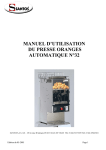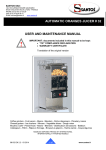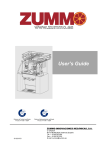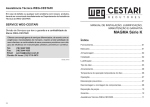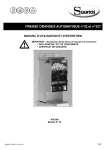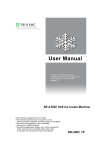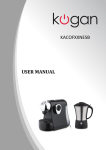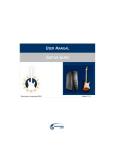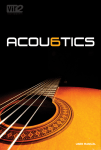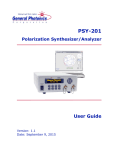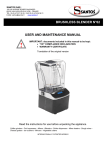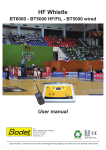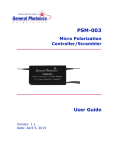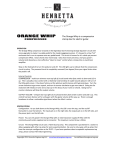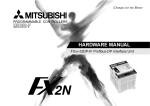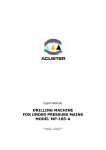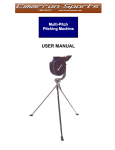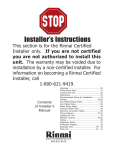Download MANUEL D` UTILISATION DU PRESSE ORANGES AUTOMATIQUE
Transcript
USER’S MANUAL AUTOMATIC ORANGE JUICER N°32 SANTOS S.A.S 140 – 150 Avenue R.Salengro 69120 VAULX EN VELIN TEL 33 (0) 472373529 FAX 33 (0) 478265821 Edition du 04-2005 Page 1 Page 1. Description 3 2. Operation 3. Characteristics 6 11 4. Operating 12 4.1 4.2 4.3 4.4 5. Safety Instructions Preliminary checking Loading Oranges Adjusting the juice extraction pressure 12 12 13 14 Maintenance 15 6. Illustrated Parts Lists Edition du 04-2005 28 Page 2 DESCRIPTION The number 32 automatic orange juicer consists in 6 major parts : - oranges’hopper (1) - chute (2) with dumper (3) - knife (4) - squeezer’s holder (5) ,with selector and linkage - tank with 2 cones (6) -control sections consisting in: o Power pilot lamp(7) o “START”pushbutton (8) o “PAUSE”pushbutton (9) o “START”and emergency stop button(10) A glass holder (11) is provided with N° 32 (tabletop version) A rolling table is provided with N° 32 T Edition du 04-2005 Page 3 A protective cover (1) is attached to the back of the machine. Easy to remove it is also used to channel orange skins. The space under the protective cover should allow a free passage to the orange skins. Two options may complement the N° 32 : 1) A juice tank (référence n°32 800) (1) (2) (3). Delivered with attaching kit Net weight : 4.4lbs (2,5 kg) Shipping weight : 6.6 lbs (3kg) Edition du 04-2005 Page 4 2) A special table fitted with: A receptacle (1) receiving a plastic bag or a bin to colect the skin at the rear. A glass holder (2). Net weight : 52.8 lbs (24 Kg) Shipping weight : 63.8 lbs (29 Kg) The table bought as an option is referenced 32820 The model equiped with the table is n° 32T Edition du 04-2005 Page 5 2) Operation The basic movement of the machine is the alternative vertical translation of main shaft (2) protected by rubber boot (1). The drive mechanism for main shaft, driven by a geard motor, mainly consists in the following items : - driving gear (3), chain (4), driven gear (6), connecting rod (7), chain bending gear (5). Machine operation is controlled by an electronic device which in case of blocking, reverses motor rotation for a while, till the squeezes are in upper position, then stops the machine. Edition du 04-2005 Page 6 The up and down movement of the main shaft give the following cycle: Phase 1 :1st upstroke of the vertical shaft. As the upstroke completes, selector (1) from the hopper into the feeding chute. The orange is then positioned by gravity, waiting at the end of upper feeding chute (2) and above dumper (3). Phase2 :1st downstroke of the vertical shaft. As the downstroke completes, dumper (1) transfers orange 1 into lower feeding chute (2). Orange 1 is then positioned by gravity, waiting at the end of this chut, stopped by a metal sheet. . Edition du 04-2005 Page 7 Phase 3 : 2nd upstroke of the vertical shaft. As the upstroke starts, orange 1 positions above the knife. As the upstroke completes, the selector transfers orange 2 from the hopper into the feeding chute. Orange 2 is then positioned by gravity waiting at the end of the upper feeding chute and above the dumper. Phase 4 : 2nd downstroke. The orange1 is cut into two pieces, and each half-orange is positioned, waiting to be transfered to the cones. As the downstrokes completes, the dumper transfers orange 2 into the lower feeding chute. Orange 2 is then positioned by gravity waiting at the end of this chute, stopped by a metal sheet. Edition du 04-2005 Page 8 Phase 5 : 3 rd upstroke of the vertical shaft. As the upstroke starts, orange 2 positions above the knife. Simultaneously, both half-orange 1 are positioned above the cones. As the upstrokes completes orange 3 is selected. Orange 3 is then selected by gravity, waiting at the end of the upper feeding chute and above the dumper. Phase 6 : 3rd downstroke of the vertical shaft. As the downstroke starts, orange 2 is cut into two parts and each half-orange is positioned waiting to be transferred to the cones. As the downstroke completes, the dumper transfers orange 3 into the lower feeding chute.Orange 3 is then positionned by gravity, waiting at the end of this chute, stopped by a metal sheet. Both half-oranges 1 are pressed between squeezers and cones. . Edition du 04-2005 Page 9 Phase 7 : 4th upstroke of the vertical shaft . As the upstroke starts, orange 3 positioned above the knife. Simultaneously, both half-oranges are positioned above the cones and half -skins of orange 1 are ejected to the rear of the machine. As the upstrokes completes, orange 4 is selected.Orange 4 positions then by gravity, waiting at the end of the upper feeding chute and above the dumper. This description in 7 steps with empty machines departure is the most appropriate method to explain the different phases, but when the cycle is initiated, everyone will notice that each of the oranges 5, 6, 7, 8...will be pressed at each downstroke of the vertical shaft. Please notice : when cycle is initiated : 2 half pressed at each downstroke 1 orange cut at each downstroke 2 half ejected at each upstroke. . Edition du 04-2005 Page 10 3) CHARACTERISTICS - Power supply : single phase (réf. 32et 32T) 220 –240 V 50 Hz, (réf. 32V1et 32TV1) 115 V 60 Hz, (réf. 32V4et 32TV4) 220 V 60 Hz - Power 9 : 600 Watts - Output : about 20 oranges/minute (cut, pressed, and ejected automatically) - Diameter oranges : Oranges from 60 to 85 mm are accepted without any previous sorting. - High capacity feeding hopper : about 22 lbs(10kg) - Excellent quality of juice, no zest (no biterness) - Easy maintenance, cleaning with both hot or cold tap water (high pressure excluded), and this through its stainless-steel construction for the body, and risen coated aluminium for the tank. - Patented system of spring-fitted extractors for orange skins. - Net weight : 134.2 lbs - Shipping weight :147.4lbs - Made in France. International patents. Edition du 04-2005 Page 11 4) Operating 4.1) Safety instructions - Make sure the power cord is connected to a socket including earth connection . - Make sure the power supply complies with the manufacturer’s plate behind the machine. - Never use extension cord. Notice : The juicer will only operate when door is closed and locked. 4.2) Preliminary checkings Before starting the orange juuicer, check that : - The knife is correctly positionned. - The two cones are correctly positionned in the tank. - The various items are clean. - The various rods are not damaged and springs attached to them are in operating condition. Edition du 04-2005 Page 12 4.3 ) Loading oranges - To obtain the best results, oranges must meet the following criteria : - No wrapping papers or stickers - 60 mm < diameter < 85mm(a calibration device prevents insertion of any orange with a diameter exceeding 85 mm. - Oranges must be of good quality, sained, not bruised (a spoiled orange may disturb the correct machine operation ). With these criteria being complied with, oranges are placed in the hopper (22lbs max) and not directly in the feeding chute. As a matter of fact, the orange transfered from the hopper to the chute is performed automatically. During operation, shutter (1) located above upper feeding chute (2) must be lowered. Its opening is justified only if the upper feeding chute is clogged by one or more oranges of poor quality. Edition du 04-2005 Page 13 4.4 Adjusting the juice extraction pressure The extraction pressure is considered as suitable when the maximum of juice is extracted without tearing the orange skin.The extraction pressure thus depends on the skin thickness and variety of oranges. To adjust the pressure just scraw or unscraw the screw (1) (maximum stroke: 5mm) using a 5 mm diameter rod inserted into rods. => Increase pressure => Decrease pressure Maximal pressure Minimal pressure To get the best juice quality and output, and in order to limit the adjustment frequency, it is advised to, as far as possible, always use the same variety of oranges. (Same skin thickness). Edition du 04-2005 Page 14 5) Maintenance In order to ensure correct operation of the orange juicer, the following table shows the maintenance operations and frequencies to be complies with. Maintenance operations Overall cleaning Frequencies After each use if stopped for more than half an hour Sheet n° 1 Every 6 months Once a year 2 3 Once a year 4 (1) Once a year 1 (1) Every two months Replacing springs Checking rubber boot and main shaft (1) These maintenance sheets are completed by the following description sheets: - Sheets n° 5 : Disassembly and assembly of knife a filler. - Sheets n° 6 : Assembly and disassembly of cones. Nota : For this operation ,we advise to use grease –KLUBER STRUCTOVIS P00 Edition du 04-2005 Page 15 Overall cleaning Ingredients : - Hot water (high pressure excluded). - Cold water (high pressure excluded) - Disinfectant solution Sheet N° 1 ½ Tools : - Jet or non-abrasive sponge or soft cloth - Portable pressure water sprayer, with adjustable pressure, 5 liters capacity is provided with the machine. Preliminary steps : - Stop using the machine using the “PAUSE” button, thus stopping the machine with the squeezers in upper position . - Unplug the machine - Unlock and open the door - Remove the knife carefully and the filter (see sheet n°5) - Disassemble the 2 cones (see sheetn°6) - Disassemble the rear protector and clean it. Operating procedure: - Cleaning during the day : The orange juicer must be cleaned every 4 operating hours or between 2 stops if the interruption is longer than half an hour (it is important never to leave the juice dry on the machine, especially on the knife). - Strictly follow the preliminary steps - Clean with hot water (high pressure excluded) the inside of the machine (including mechanism.Completely remove all the pulp or sking pieces and undesired matters. - Wash the knife, filter, cones and glass holder. Edition du 04-2005 Page 16 Overall cleaning SheetN° 1 2/2 N - Install the glass holder, cones (n°6), filter, then knife (see sheet n° 5). With hot water, clean the outside of the machine 1) Cleaning at the end of the day : the orange juicer should be cleaned first with hot water (see 1, cleaning during the day), then with disinfectant solution. It should therefore, be thoroughly rinsed (use water jet if required, but not high pressure before installing the various items (cones, filler, knife) Opérations complémentaires: - Install the rear protected cover Close and lock the door Plug the machine Note : The rear protective cover as a safety: it is not possible to start the machine without this cover. Edition du 04-2005 Page 17 N° 2 ½ - Ingredients: - None - Spares - Springs 1 and 2 (réf. 32 279). - Springs 3 (ref 32245) and 4 (ref. 32 244). Springs 5(ref 32 327) and 6 (ref.32 326) Springs 7 and 8 (ref. 32 261). Springs (ref144) - Preliminary steps : - Stop the machine by the “PAUSE” switch (squeezers in upper position) - Unplug the machine - Operating procedure: - Follow the preliminary steps Tools: -None LEFT - RIGHT Unlock and open the door Edition du 04-2005 Page 18 Replacing springs Sheets n°2 2/2 - - Replace springs 3, 4, 5 and 6 with caution - Remove the rear protective cover and rear upper panel - Replace both springs(7 and 8) taking care to well position the hooking loops for new springs in the grooves of plastic hinge bushes Complementary operations: - Edition du 04-2005 Page 19 Checking the rubber boot and the main shaft Ingrédients : - Grease STRUCTOVIS POO Water Sheet n°3 ½ Matériel : - Screwdriver Replace if required - Rubber foot (ref 32432) Preliminary Steps - Switch off the machine using the pause button,squeezers in upper position Unplug the machine Operating procedures: - Follow the preliminary steps Remove the rear protective cover and rear upper panel. Check boot (1). Replace if required (presence of tears) Remove lower clamp and lift the boot Clean the main shaft with water, and dry it.Grease if necessary. Edition du 04-2005 Page 20 Checking the rubber boot and the main shaft Sheet n°3 2/2 Complementary Steps: - Install the rear upper panel and rear protective cover Close and lock the door Plug the machine Edition du 04-2005 Page 21 Checking the drive mechanism Ingrdients : - Silicone grease Sheet n°4 ½ Tools: Screwdriver Spares - Driving gear ref 32 666 (13 teeth) Bending gear ref 32 555 Driven gear ref 32 520 Chain ref 32 582 (70 links) for 60 Hz, réf :32 583 (64 links) for 50 Hz Complete chain device ref 32 540 Bending spring ref 32 560 Preliminary steps: - Stop the machine with the PAUSE button (squeezers in upper position) Unplug the machine Operating procedure: - Follow the preliminary steps Remove the lower front panel (1) Check chain (2) tension and bending spring.Replace the spring if necessary (3) Check the gear (4, 5 and 6). Replace if necessary Check the chain (2) condition . Replace if necessary Grease chain (2) if necessary Edition du 04-2005 Page 22 Checking the drive mechanism Sheets n°4 2/2 Complementary Steps: - Install the lower front panel Plug the machine Edition du 04-2005 Page 23 Disassembly and assembly of knife and filler Sheet N° 5 Ingredients : Tools : - - None None ½ Preliminary Steps: - Stop the machine with the “Pause”button, squeezers in upper position Unplug the machine Unlock and open the door. Operating procedure: - Removal : - Follow the preliminary steps - On models before 1993 : unscrew the black nut (1) - Slightly pull knife to the front, so as to bring holes (3) in plates (4) in front of pines (5) - Lift and remove complete knife - Remove filler (6) located in the tank bottom - Installation: - Correctly install filter (6) in the tank bottom. - Engage slot (7) of plate (4) under black knurled nut (1) (on models before 1993), bring holes (3) inplates (4) in front of pines (5) Push knife (2) fully to the rear Tighten knurled nut (1) (on models before 1993) - Edition du 04-2005 Page 24 Disassembly and assembly of knife aned filler Remove Sheet N° 5 2/2 On models before 1993 Put Down Complementary Steps: - Close and lock the door Plug the machine Edition du 04-2005 Page 25 Installation and relmoval of the cones Sheets N° 6 Ingredients : Tools - None - None ½ : Preliminary Steps: - Stop the machine using the “pause” button (squeezing uppper position) Unplug the machine Unlock and open the door Remove the knife (see sheet n°5) Operating procedure: - Removal - Follow the preliminary steps - Lift each cone (1 and 2) in order to separate them from their respective shaft inside the tank Remove each cone from the machine - Separate each cone (3) from its respective base (4) - Separate spring (7) and ejector from each cone (3) - Installation - Install spring (7) and ejector (8) on each cone (3) - Place each cone (3) on its base (4) - Insert 6 pins (3) into corresponding holes (6) in the base by simply pressing. Edition du 04-2005 Page 26 Installation and removal of the coves Sheet n°6 2/2 Place each cone on each shaft in the tank bottom. Complementary Steps: - Install the knife (see sheet n°5). Close and lock the door Plug the machine Edition du 04-2005 Page 27 Greasing Sheet N° 7 1/1 Tools : standard grease pump.Grease KLUBER STRUCTOWS POO - The machine has a standard greasing point on the rear panel Every 2 months approximately, grease this point (approximately 5 pressure at the point) Edition du 04-2005 Page 28 Illustrated Part List Plate 1: Steel sheed construction / body and electrical controls Plate 2 : Squeezer holder assembly Plate 3 : Knife assembly and tank assembly Plate 4 : Geared-motor support assembly Plate 5 : Geared-motor assembly Plate 6 : Wiring diagram For any order of spares, use the 5 digit order such as 32 XXX. Edition du 04-2005 Page 29 PLATE 1 Steel sheed construction/ (32100) body and electrical controls (32700) Edition du 04-2005 Page 30 PLATE 2 Squeezer holder assembly (32200) Edition du 04-2005 Page 31 PLATE 3 Knife assembly and tank assembly Edition du 04-2005 Page 32 PLATE 4 Geared -motor support assembly (32500) Edition du 04-2005 Page 33 PLATE 5 Geared-motor assembly (32600) Edition du 04-2005 Page 34 Edition du 04-2005 Page 35 Edition du 04-2005 Page 36 White White Blue Brown Black Brown Blue MOTOR Black Black Black Brown Red light White Black White Capacitor White Electronic Module Blue Brown Brown Purple Purple Brown Edition du 04-2005 ILS SECURITIES Blue Page 37 White Black Yellow Blue Brown White Red MOTOR Black Black Brown Bleu Black Black Brown Red light White Capacitor White Electronic Module Blue Brown Brown Purple Purple Brown Edition du 04-2005 ILS SECURITIES Blue Page 38 Edition du 04-2005 Page 39







































